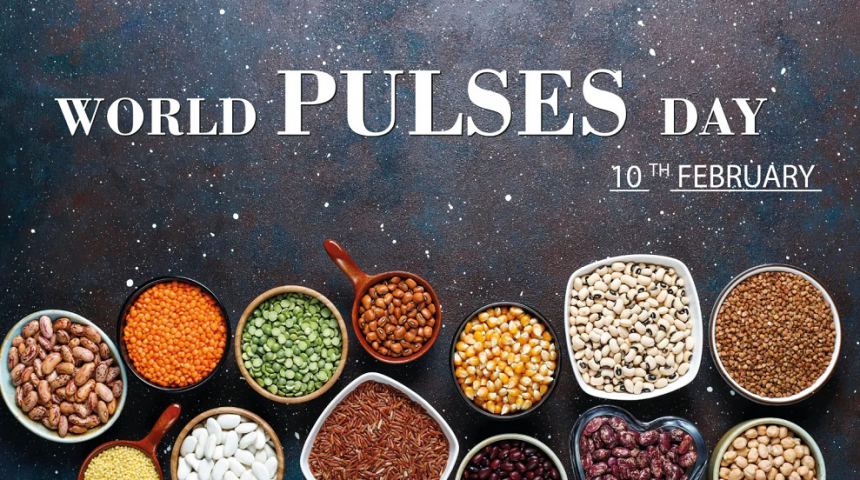WORLD PULSES DAY
No doubt, the green revolution era of the seventies turned the fortunes of the country in so far as food production is concerned. The phenomenal increase in the production of wheat and paddy due to high yielding varieties and use of chemical fertilizers made the country self sufficient and the dependence on imports was reduced to a considerable extent. From a ‘begging bowl’ to becoming a ‘bread basket’ green revolution deserves to be credited. Unfortunately, the major focus of green revolution was Paddy and Wheat which resulted in neglect of a vital group of crops i. e pulses. Pulses were pushed to the marginal lands. Over the years, the lack of any substantial policy support also resulted in decrease in area under their cultivation. Ultimately, all this led to an adverse bearing on the productivity and overall production of the pulses. Pulses are still cultivated on the marginal and degraded lands, predominantly under rainfed conditions.
Pulses have the unique distinction of being grown in both ‘Kharif ‘as well as ‘Rabi’ season and are the leguminous crops harvested for dry grains, yielding seeds of variable size, shape and colour within a pod and used both as food and feed. However, ‘Rabi’ pulses contribute more than 60 per cent of the total production. Pulses exclude crops harvested green for food which are classified as vegetable crops as well as those crops used mainly for oil extraction and leguminous crops that are used exclusively for sowing purposes. An important source of protein, this group of crops also contributes to soil health and mitigating climate change trough their unique nitrogen fixing properties. The major pulses grown and consumed in India include Pigeon Pea (Arhar/Tur/Red Gram), Green Beans (Moong Beans), Bengal Gram (Desi Chick Pea/Desi Chana), Black Matpe (Urad/Mah/Black Gram), Black Eyed Peas (Lobia), Lentils (Masoor), Chick Peas (Kabuli Chana), White Peas (Matar) and Red Kidney Beans (Rajmash).
The country is the largest producer (25% of global production), consumer (27% of world consumption) and importer (14%) of pulses in the world. Pulses account for around 20 per cent of the area under food grains and contribute around 7-10 per cent of the total food grains production in the country. Gram is the most dominant pulse having a share of around 40 per cent in the total production followed by Tur/Arhar at 15 to 20 per cent and Urad/Black Matpe and Moong at around 8-10 per cent each. Madhya Pradesh, Maharashtra, Rajasthan, Uttar Pradesh and Karnataka are the top five pulses producing States. Productivity of pulses is 7.6 q/ha. The production of pulse such as Tur, Urad and other lentils across India was estimated to be over 24 million metric tons in 2024. The 2024-25 figures were lower than the average production between 2014-15 and 2024-25 and also lowest of last nine years.
The trend of commercialization of agriculture has further aggravated the status of pulses in the farming system. There is very little value addition for pulses. Pulses are mostly consumed whole or split, apart from desi chickpea which is usually consumed in the form of flour/besan and has growing demand. Most of the processing units are production regions mainly to minimize the transportation cost for procuring raw materials and use traditional technology. However, the growing health consciousness, preference for quality packaged products and shortage of labour drives the processors to use modern technology.
Due to their ability to grow without support of any external inputs, pulses were well integrated into the different farming systems prevalent in diverse agro-climatic zones. They are packed with nutrients and have high protein content. It is estimated that pulses contain 20-25 per cent of protein by weight and have twice the protein available in wheat and thrice that is present in rice. This makes them an ideal source of protein particularly in rainfed and resource poor regions where meat and dairy products are not physically or economically accessible to peoples. Pulses are also low in fat and rich in soluble fiber which can lower cholesterol and help in the control of blood sugar. Due to these immense benefits, these are recommended by health organizations for the management of non-communicable diseases like diabetes and heart conditions also.
Pulses have also been shown to help combat obesity. These are low in sodium, rich in potassium and good source of iron. Pulses are reported among the top high fibre foods, necessary for supporting digestive health and helping to reduce the risks of cardiovascular diseases. These are also classified as an excellent source of folate, a B-vitamin naturally present in many food essential to the proper functioning of nervous system and especially important during pregnancy to prevent fetal defects. In addition to its nutritional advantage, pulses have low carbon and water footprints which make them an integral part of the sustainable farming system.
As per estimates, water footprints for producing one kilogram of meat are five times higher than that of pulses. Further, one kilogram of legume emits 0.5 kilogram in CO 2 equivalent whereas one kilogram of meat produce 9.5 kilogram in CO 2 equivalent. Pulses are highly water efficient: for producing 1 kg of lentils needs 1250 liters, while 1 kg of beef requires 13,000 liters. Intercropping with pulses increases farm biodiversity and creates a more diverse landscape for animals and insects. Pulses are low Glycemic index foods and help to stabilize blood sugar and insulin levels making them suitable for people with diabetes.
Despite all this importance, per capita net availability of pulses in India is not at par with the recommendation. The per capita availability has shown an unusual trend from 51.1 gm/day (1971) to 41.9 gm/day (2013) to 53 gram/day in 2022 and about 47 grams of pulses were available per capita in the country. However, the World Health Organization recommends 80 gm of pulses/day.
World Pulses Day (Feb.10)
Recognizing the value of pulses in ensuring nutritional and environmental security the UN General Assembly on 20 December 2013 adopted a resolution (A/RES/68/231) proclaiming 2016 as the International Year of Pulses (IYP). The celebration of the year, led by the Food and Agriculture Organization (FAO) of the United Nations (FAO), increased the public awareness of the nutritional and environmental benefits of pulses as part of sustainable food production. Building on the success of the International Year of Pulses and recognizing their potential to further achieve the 2030 Agenda for Sustainable Development, with particular relevance to Sustainable Development Goals 1, 2, 3, 5, 8, 12, 13 and 15, Burkina Faso proposed the observance of World Pulses Day. In 2019, the General Assembly proclaimed 10 February as the World Pulses Day vide resolution A/RES/73/251. This year the theme of World Pulses Day is, ‘Pulses: Bringing diversity to agri-food systems. The theme highlights the vital role of pulses in promoting diversity-both above and below the ground. Integrating pulses into our diets and agri-food systems, we unlock a more sustainable, nutritious and equitable future.
Pulses have been rightly called as the pulse of the nation. As pulse defines life, pulses ensure nutritional security for the lives. So there is an urgent need to work towards raising its productivity by development of high yielding, climate and disease resilient varieties of pulses and improved production and protection technologies. The ICAR in collaboration with State Agricultural Universities is undertaking basic and strategic research on pulses for developing location-specific high yielding varieties along with package of practices. The National Food Security Mission NFSM-Pulses initiative of the Government of India operational in 28 States and 2 Union Territories including Jammu & Kashmir and Ladakh aims to augment the pulse production in the country. During the period from 2014 to 2023, an impressive 343 high-yielding varieties and hybrids of pulses have been officially recognized for commercial cultivation across the country.
To bring in Self reliance in pulses, in the Union Budget 2025-26, Finance Minister has announced a 6-year mission aimed at achieving self-reliance in pulses, with a special focus on Tur (Pigeon Pea) Urad (Black gram) and Masoor (Lentil). Central agencies such as National Agricultural Cooperative Marketing Federation of India (NAFED) and National Cooperative Consumer’s Federation (NCCF) will be prepared to procure these three pulses from farmers who register with the agencies and enter into agreements.
(Author writes on agriculture and social issues and can be reached at: [email protected])








